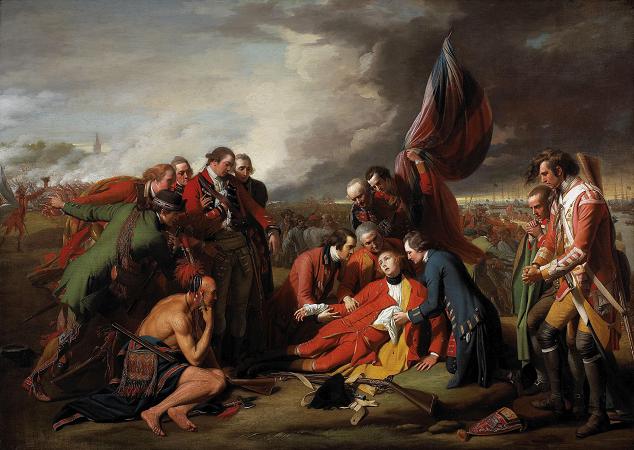Death of General Wolfe (1770). Oil on canvas. 151 x 213. The Death of General Wolfe is a painting by Anglo-American artist Benjamin West, commemorating the 1759 Battle of Quebec, where General James Wolfe died at the moment of victory. The painting carried vivid suggestions of martyrdom, and broke a standard rule of historical portraiture, by featuring individuals who had not been present at the scene, dressed in modern instead of classical costumes. Painted in 1770, it has become one of the best-known images in English art. The Death of General Wolfe depicts the Battle of Quebec, also known as the Battle of the Plains of Abraham, on September 13, 1759. This was a pivotal event in the Seven Years' War and decided the fate of France's colonies in North America. The battle was fought between the British Army and the French Army; the pitched fighting lasted only fifteen minutes. The British Army was commanded by General Wolfe. Although successful in holding the British line against the French and winning the battle, General Wolfe was mortally wounded by several gunshots. In death, General Wolfe gained fame as a national hero. He became an icon of the Seven Years' War and of British dominance in late eighteenth century North America. West depicts General Wolfe as a Christ-like figure. This painting has a triangular composition, made by the top of the flag and the positions of the men. It resembles Christian Lamentation scenes, where Christ is held in the embrace of the Virgin Mary. Captain Hervey Smythe is pictured holding Wolfe's right arm. The depiction of the Indigenous warrior in the painting, kneeling with his chin on his fist, looking at General Wolfe, has been analyzed in various ways. In art, the touching of one's face with one's hand is a sign of deep thought and intelligence. Some consider it an idealization inspired by the noble savage concept. Original items of clothing that were used as a model for portraying the warrior in the painting can be found in the British Museum's collection. On the ground in front of Wolfe are his musket, cartridge box, and bayonet. Wolfe went into battle armed as his men were, although his musket was of higher quality. His dress is also of note. He is wearing a red coat, a red waistcoat, red breeches, and a white shirt. Such dress was rather simple, especially for a commanding officer. Next to Wolfe, in the blue jacket, is Dr Thomas Hinde, who is attempting to stem the bleeding from Wolfe's wounds. The general later died in the doctor's hands. In the background, and to the left of the men surrounding Wolfe, an approaching runner is depicted. He is waving his hat in one hand to attract their attention, and with the other hand carries a captured flag with the Fleur-de-lis, symbolic of the news relayed to the dying Wolfe that the French were being defeated. The inclusion of Simon Fraser, Lieutenant Colonel of the 78th Fraser Highlanders is interesting, as General Wolfe reportedly spoke highly of Fraser's regiment, yet Fraser was not at the battle, as he was recovering from wounds received earlier. In the painting, Fraser wears the Fraser tartan, which was probably worn by officers in that regiment. All in all only four of the fourteen men depicted were actually at the battleground. West's choice to depict his subjects in contemporary clothing was highly controversial at the time. Although the depicted events had taken place only eleven years prior, the prevailing convention of West's time would have been to convey such subject matter in a history painting; an artistic tradition in which the portrayal of contemporary dress was considered unsuitable. During the painting process, Sir Joshua Reynolds instructed West to clothe the subjects in classical attire, to which West declined. After completion of the painting, George III refused to purchase it, believing that West's choice of clothing compromised the dignity of the image. However, subsequent years brought a shift in opinion and artistic convention, and the painting was largely redeemed, overcoming earlier objections and inaugurating a practice of greater contemporary accuracy in history painting. The painting was originally exhibited at the Royal Academy in London, England. It was presented to Canada in 1921 as a tribute for its service in the First World War. William Woollett's engraving was the best-known copy of West's original painting and became popular around the world. A black-and-white copy of the engraving can be seen at Brodick Castle on the Isle of Arran, Scotland. Besides the original, at least four other additional versions of the Death of General Wolfe were also produced by West.
more...




